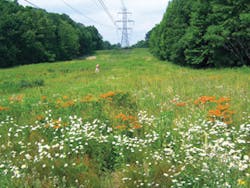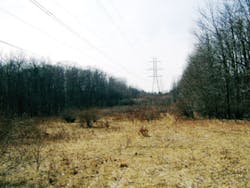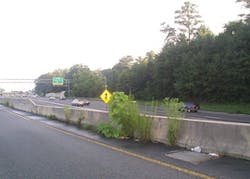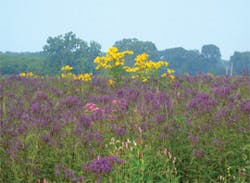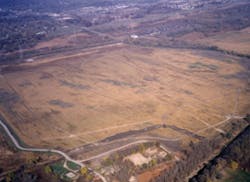Stony Creek Metropark
The Metropark complex consists of a ring of 13 parks located along Michigan’s Huron and Clinton Rivers, forming a greenbelt around the Detroit metropolitan area. One of these Metropark facilities is known as Stony Creek, comprising 4,461 acres of scenic, hilly terrain, in addition to prairies and swamps. Within the park is the 500-acre Stony Creek Lake; miles of trails for mountain biking, hiking, jogging, inline skating, and bicycling; snowboarding and sledding hills; two beaches; a nature center; an 18-hole golf course; and considerably more. Wildlife, such as osprey, wild turkeys, and deer, are found in the park as well.
Before restoration
Also in the park are high-powered transmission lines belonging to ITC Holdings, an independent electric transmission company. That’s where Rick Johnstone comes in. He is the owner of Vegetation Management with Environmental Stewardship LLC, as well as the president of Integrated Vegetation Management Partners (IVM Partners). IVM Partners is a nonprofit corporation acting as a liaison among industry, public agencies, conservation groups, and academia to promote best vegetation management practices. The group works to resolve vegetation management problems, control invasive weeds, and improve wildlife habitat.
Johnstone notes that when a local power utility has equipment within park boundaries, as in Stony Creek Metropark, the utility may have one set of needs from a vegetation management standpoint, while the park has different priorities. For example, the utility company might not be particularly concerned about small weeds because they won’t grow tall enough to be troublesome to power lines. But park personnel may well want even these small weeds to be controlled. Johnstone has found, however, that often the two entities can work smoothly together to form a nice synergy. The park might work to accommodate the needs of the utility, and the utility in turn might go beyond its own requirements to facilitate those of the park.
Such is the case with Stony Creek Metropark, located about 26 miles from downtown Detroit. The electric company is concerned with the growth of silver maple, red maple, oaks, ash, and pines. As Johnstone explains, “The electric company can’t have such trees growing under power wires-they interfere with the power lines and can cause a massive power outage,” as occurred in much of the northeastern US in 2003.
On the other hand, the utility is not troubled by the growth of small shrubs, but Johnstone has stressed that
Reintroducing vegetation along Colorado Highway 67
even though these shrubs won’t grow to a height to directly interfere with power lines, they present another concern. Invasive shrubs, such as autumn olive, buckthorn, and multiflora rose, can expand across the right of way, restricting workers’ access to utility poles and lines. Managed properly, he notes, such shrub control is a major help to the utilities, not simply an unnecessary expense.
Another benefit is that proper weed control acts to bring back native species that haven’t prospered in many years. In the past, when there were many open fields to be found, vegetation management occurred naturally in the form of occasional fires that occurred from lightning strikes. Native species were thereby maintained without any special effort.
In many areas, there is no vegetation control other than occasional cutting or mowing, but this can result in invasive shrubs and other species taking over. But with proper maintenance to control the unwanted invasive plants, the result can be natural shrubs that provide a number of benefits. They offer a good habitat for songbirds, and wild meadow flowers and grasses can provide a good environment for native pollinators such as butterflies and honeybees. Such pollinators crisscross agricultural land and are an important pollinating source for our crops.
Johnstone explains that he is not involved with new plantings. Instead, “I take advantage of nature. You have a goal of what you’re looking for, and we work to keep out unwanted plants so that we end up with compatible groundcover. The result is not only a more desirable vegetation mixture, but this also results in the input of manpower decreasing as nature takes over.”
It is important to know which herbicides to use and when to use them. This depends, of course, on the individual project. Johnstone often selects a combination herbicide and finds that he is therefore able to use less herbicide with better results.
For the Stony Creek project, he primarily uses a combination of three herbicides together to inhibit the growth of unwanted invasive species: Arsenal, a BASF product, and both Krenite and Escort from DuPont. At times, he combines them with Thinvert, which, instead of acting as a water carrier for these herbicides, produces a paraffin-like material. It sticks better where it is applied, encapsulates the spray better, and minimizes any drift of the combination herbicide off-target. He also uses Milestone from Dow specifically to control spotted knapweed and Canadian thistle.
During and after his projects, Johnstone works with a botanist to document the changes that occur. For example, he may be able to demonstrate a change from 90% of unwanted invasive species (pretreatment) to 10% (post-treatment).
He has also arranges for the installation of nature trail signs showing what was growing in the area before, and the more compatible species that are currently growing. This allows for an ongoing education for the public.
Johnstone notes that it’s been a lengthy process convincing various stakeholders that it’s possible to have such synergy among industry, government agencies, and conservation groups. Around the year 2000, he spoke with a variety of federal agencies and found that they often took the stance “You can cut, but you can’t use herbicides.” Even after the major blackout in 2003, he still saw little or no improvement in the situation. He then spoke with the National Fish and Wildlife Foundation, which was interested in his suggestions for better control of invasive species. It could not provide funding to private utilities or organizations, but it assisted him in setting up a nonprofit company to conduct research, educate, and act as a liaison between various government agencies and the utilities. More often than they may realize, Johnstone says, what the utilities want is the same as what the federal agencies want.
Controlling roadside and roadway plant growth can be laborintensive, costly, and a safety risk to workers.
At Stony Creek, the former owner of the property (Detroit Edison) had done virtually nothing but cut back the trees every so often, but Johnstone found areas that were still overrun with undesirable trees. He spoke with the Metropark personnel and proposed various control methods. They liked his proposal, but suggested that he carry it out in small stages. Now, there are wetland meadow grasses growing, native species are again flourishing, and prairie is returning. He went back and proposed cutting back some trees, as well as using some herbicides for control. He was very clear in identifying precisely what he was planning on doing. He’s careful to use an appropriate herbicide combination for any given project. For example, if he’s working with wetlands, he’ll only use wetland-approved herbicides.
The result has been pleasing to all parties. “It’s gone as we’ve said it would, so everyone is happy,” Johnstone proudly proclaims.
Hayman Fire and Flood
In early June 2002, central Colorado was hot and dry, and high winds were blowing. The mixture proved deadly when a campfire grew into what would become the largest forest fire in state history. Before it was contained weeks later, it consumed 138,000 acres, destroying nearly 600 structures, including 133 homes. The destruction came to be known as the Hayman Fire, named for its point of origin. Millions of ponderosa pine and Douglas fir trees were lost, as well as hundreds of miles of park roads.
Mike Banovich, a landscape architect with the Colorado department of transportation, was given the task of reintroducing vegetation along portions of state Highway 67. Surveying the scene and seeing that in many areas the topsoil was essentially gone, Banovich decided that to stimulate plant growth he needed to apply liquid organic-based fertilizer to the subsoil. The goal was to establish native grasses in the very steep terrain.
The work proved successful initially, but the still-massive loss of vegetation left the area defenseless against flooding from heavy rains. On July 7, 2006, a 100-year thunderstorm drenched the area with between 2 and 4 inches of rain. Miles of Highway 67 were again decimated.
Banovich describes what he found in the aftermath of the torrential rains. “The flood blew out 6 miles of highway and left perhaps 20% of the trees in the area. Everything else, including the native grass, was scoured out.”
Highway reconstruction was quickly undertaken, with the roadway reopening at the end of October 2006. Maintaining local traffic through the area required close coordination among the construction contractors, traffic control, and the Colorado state patrol.
In order to reestablish the native grasses, Banovich again used the same strategy of the application of liquid organic fertilizer. He used about 600 pounds per acre of granulate humate, composed of various organic matter, together with 1,200 pounds per acre of organic fertilizer. Approximately 40 acres were treated.
The humate/fertilizer combination serves to increase the ability of the soil to hold water, stimulates seed germination and viability, and increases the uptake of proteins and minerals by plants. At times, Banovich has used the organic fertilizer Biosol, from Bowman Construction Supply in Denver, containing mychorrizae. These fungi help roots absorb nutrients and are often used in “dead zones”-areas scoured by forest fires or construction excavation.
Previously, Banovich had attempted to establish vegetation in such dead zones by importing topsoil, but found that this often led to poor quality growth of native species. He has found the most success by first establishing native species through the use of organic fertilizer; then the competition from these well-established species acts to minimize the growth of the undesired invasive species.
“Before we began to use organic fertilizer,” he says, “it was very difficult to establish vegetation on this very steep terrain, sometimes at a 2:1 slope in the high altitude-around 7,000 feet.”
The area of the Hayman Fire may not fully recover for perhaps hundreds of years, but Banovich’s work has already paid off. The portions he has treated now have full vegetative cover, including native willows and grasses.
Protecting Georgia Highways
Bermuda grass is a perennial grass that grows rapidly in warm temperatures, especially when moisture is abundant. According to the Agriculture and Natural Resources Department at the University of California, “The mature plant forms dense mats with spreading and branching stolons that root at the nodes…. It can also be an invasive weed. It was introduced from Africa (not Bermuda) in 1751 and is widely spread throughout the southwest and southern United States.”
Bermuda grass is found along roadways throughout much of the state of Georgia. One of its advantages is that it effectively promotes drainage, which aids in keeping roads free of standing water. In addition, because it stays green throughout a good portion of the year, it adds to the aesthetic appearance of Georgia’s highways.
However, Bermuda grass tends to grow rapidly, and, left unchecked, it has the capacity to reduce water runoff by clogging roadside drainage areas. It can even reduce driver visibility. Other grasses and plants that contribute to potential problems for Georgia’s highway system include ryegrass, fescue, Johnsongrass, crabgrass, thistles, dandelion, carpetweed, and beggarweed. These plants have the strength to pry open crevices and expand cracks, opening the way for other erosive forces, degrading the roadway system, and increasing maintenance over time. “If grasses and weeds get a foothold in the cracks and crevices along the pavement, we can count on a major expense and a major inconvenience for drivers,” says Ray Dorsey, agronomist manager for the Georgia department of transportation (GDOT).
Historically, simple mowing and occasional herbicide applications have been the means of controlling roadside and roadway plant growth. But these are labor-intensive, costly, and not without safety risks to workers.
Dorsey explains that he previously tried controlling excessive plant growth with the use of a bromacil herbicide, but he had concerns about leaching and off-target damage: “It was effective on grasses and weeds in the cracks, but, in my opinion, it didn’t bind tightly enough to the soil.” Dorsey says that his crew also had to time treatments carefully to avoid further movement of the product. “Treatments had to be done at very specific times, so we often had to drop other treatments to do our crack-and-crevice work,” he explains. “This wasn’t a very efficient use of our time.”
Currently, he says, “We utilize about 20 or so different herbicides, depending on mode of action and target species.” In particular, he says, “We use Journey [by BASF] and Roundup Pro [by Monsanto] herbicides for pavement weed control.” Dorsey’s department still goes out on mowing runs, but instead of four to six mowings per year for any given stretch of roadside, the chemical herbicides have reduced mowing to about twice annually.
“We use a wide variety of equipment for crack-and-crevice treatments. It’s important to match the application technique to the size and type of the infestation,” he says. “Doing the applications right the first time also helps keep our workforce safe by eliminating the time they spend doing repeat treatments in high-traffic areas.”
Dorsey’s total annual vegetation management budget comes to about $22 million for the entire state, so any savings he can find ultimately helps to keep Georgia’s roadways both safe and beautiful.
The Journey herbicide that Dorsey uses has proven effective in the seedhead suppression of a number of the plants that he battles, including pesky fescue and the Bermuda grass noted above. Because it binds to the soil, there is less concern about runoff and off-target damage. In addition, his current combination of herbicides can be effective with fewer applications than what he previously was using, so this also adds to his cost savings.
Of course, there are still worker safety issues with which to contend. “Most of the metro Atlanta pavement weed control is performed at night by a contractor,” Dorsey notes. “Traffic counts are so much lower during those times. In other areas of the state, we may have to close lanes or have buffer-type vehicles when using herbicide trucks in a slow-moving operation.”
In addition, he says, “We avoid treatments around all waterways and bodies of water. We also avoid environmentally sensitive areas, such as locations with endangered species. Areas where property owners are maintaining rights of way are also avoided.”
Indiana’s Lake Station is home to the state’s first full-scale private wetland mitigation bank.
Some communities around the country have ordinances controlling noise when conducting roadside work, but Dorsey indicates that he has not encountered any such restrictions.
Although much of his department’s work involves management of existing vegetation, Dorsey adds, “GDOT has crews all over the state responsible for grassing shoulders when resurfacing the pavement. We also do contract landscape plantings and maintenance for new construction and existing landscapes in the metro areas, as well as rest areas and welcome centers.”
Seeking Weeds in Canada
Controlling unwanted vegetation along miles and miles of railroad track can be a very time-consuming and labor-intensive task, as Brian Harrison can attest. He has spent more than 30 years specializing in railway application of herbicides for weed control.
His latest project involves controlling weeds along the right of way of Canadian Pacific Railways. A railroad right of way consists of the land upon which the railway tracks have been built, as well as the ballast under the rails (and ditches or other drainage structures running alongside the tracks), in addition to any adjacent embankments and the vegetation covering these slopes.
Harrison explains his task for this project: “The main concern was to cut back on chemical usage by just applying herbicide on the weed itself instead of blanketing the entire area.” To accomplish this, he selected the WeedSeeker automatic spot spray system, manufactured by NTech Industries Inc.
The heart of the WeedSeeker is its advanced-optics sensor, which identifies chlorophyll and applies selective spraying to hit the weed and nothing else. Properly used, it will kill more weeds with less herbicide. “When it senses a weed,” Harrison explains, “this triggers a solenoid with a nozzle on a boom and then sprays the weed.”
He says that in the past, weed control consisted of simple tank-mix blanket spraying, along with occasional spot spraying. Later, he used chemical injection systems with rate controllers. At present, Harrison favors the WeedSeeker technology because “it lets you do more in populated areas where just the weeds are applied-not blanket sprayed or small areas spot sprayed.”
An early concern, though, was a cap on productivity, because he found that the normally equipped WeedSeeker could be used on a vehicle traveling only up to 8 or 10 miles per hour. However, NTech designed a remote valve controller that allows herbicide application while traveling up to 30 miles per hour. Harrison claims that, ordinarily, the vehicle housing the WeedSeeker unit won’t move at a clip greater than about 20 miles per hour, but the incrementally increased speed of application means that significantly more ground can be covered in a given amount of time. “If the contractor is working by the mile, they need to cover miles,” he explains.
In the case of the Canadian Pacific Railways, he works with blocks of rail 10 to 15 miles in length, “and you would be hard pressed to complete an entire block in an hour, especially on a main line.”
The WeedSeeker sensor has a 12-inch-wide field of view. Because the ballast right of way with the Canadian Pacific Railways line is 16 feet wide, Harrison uses an array of 16 sensors mounted on a HiRail spray truck. He says that in addition to the WeedSeeker sensors, “a TeeJet Technologies chemical injection system was also installed on some units to help in regulating the amount of chemical usage and to provide the ability to apply three different products at different rates.”
Another issue to be concerned with is chemical drift, but he explains that “whether it’s an automatic system like the WeedSeeker or a chemical injection rate controller, the herbicide would always be applied with a boom system with windshields to help block the wind and keep drift to a minimum. The shields are normally at track height. In the past few years, there have been big advances in nozzles that control drift, so with the combination of both a shielded boom and the right nozzle, it can noticeably cut down drift so most of the product gets on the ground.”
In addition, he adds, “There are always government rules to follow in all provinces, and spray speeds are one of them.” Other regulations relate to how closely one may spray near a body of water or near residential dwellings. “It is up to the operator,” Harrison says, “to determine if it is safe to apply in an area, knowing the product being used, environmental conditions, and the capability of the equipment. The operator’s knowledge is the key to any job.”
Lake Station Restoration
Lake Station, on the shore of Lake Michigan in northern Indiana, is home to the state’s first full-scale private wetland mitigation bank. Ecological services firm JFNew completed the design for the 223-acre privately owned agricultural site, producing 202 acres of restored wetland.
Restoration efforts began in 1998 and were largely completed in 2000, but JFNew continues to monitor and maintain the site. The property is now part of the Indiana Dunes National Lakeshore, making it accessible to the public, and has proven to be a popular birding spot during migratory season.
To accomplish the restoration, JFNew had to coordinate agreements among the US Army Corps of Engineers, the Indiana Department of Environmental Management, the Indiana Department of Natural Resources, the Natural Resources Conservation Service, and the US Environmental Protection Agency.
In addition to removing more than 31,000 linear feet of subsurface tile, project engineers had to control non-native species such as phragmites, reed canary grass, purple loosestrife, and multiflora rose. Control consisted of backpack herbicidal spraying, hand wicking, and prescribed burning.
To introduce native species to the site, seeding of more than 70 native plant types was undertaken. These native species were carefully selected so that a species non-native to the region would not be introduced. However, non-native annual cover was initially applied to help with site establishment and to produce faster results. The annual cover crops die back after their first season, and this helps to give the native plants time to get established.
At present, there are more than 160 native plant species onsite, and wildlife use of the area has increased significantly, particularly by non-game species. In addition, some 40 species of birds have been identified using the site, including documented nesting of the state-threatened marsh wren every year since restoration.